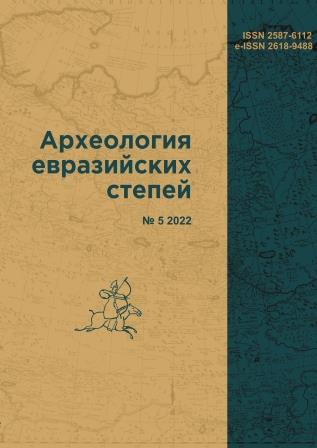Some Questions of Medieval Fortification Studies
DOI:
https://doi.org/10.24852/2587-6112.2022.5.67.73Keywords:
archaeology, Middle Ages, fortified settlements, fortification, development of military-defense business, types of constructions.Abstract
An essential component of the appearance of cities and castles during the Middle Ages were their defense systems, which included not only fortress walls and towers, but also other elements of fortification. To a large extent, they reflected the level of development of the state, containing both the military engineering index and the level of external threat, as well as concentrated scientific and technical achievements of various peoples. The fortification of medieval states demonstrated a fairly high level against the general background of the development of military defence, beginning since the era of the Ancient World. Despite the decline of fortification science in the Middle Ages, a series of traditions linked them for centuries. At the same time, along with general trends, the medieval fortification of various territories and states had a number of their own features, which were conditioned by local traditions of urban development and conditions of military practice.
References
Artem’eva, N. G. 2014. In Sitdikov A. G., Makarov N. A., Derevianko A. P. (eds.). Trudy IV (XX) Vserossiiskogo arkheologicheskogo s’ezda v Kazani (Proceedings of the 4th (20th) All-Russia Archaeological Congress in Kazan) III. Kazan: “Otechestvo” Publ., 439–444 (in Russian).
Belorybkin, G. N. 2003. Zapadnoe Povolzh’e v srednie veka (The Western Volga Region in the Middle Ages). Penza: Penza State Pedagogical University (in Russian).
Viollet-le-Duc, E. 2007. Kreposti i osadnye orudiya. Sredstva vedeniya voyny v Srednie veka (Fortresses and siege weapons. Means of warfare in the Middle Ages). Moscow: “ZAO Tsentrpoligraf” Publ. (in Russian).
In Tsepkov, A. I. (ed.). Voskresenskaya letopis'. Puteshestvie Ibn-Fadlana na Volgu (The Resurrection Chronicle. Ibn Fadlan's Journey to the Volga). Series: Russkie letopisi (Russian Chronicles). 2. Ryazan: “RINFO” Publ. (in Russian).
Golitsyn, N. S. 1877. Russkaia voennaia istoriia (Russian Military History) 1. Saint Petersburg: “Tipografiya tovarishchestva Obshchestvennaia pol’za” Publ. (in Russian).
Gubaidullin A. M. 2006. Fortifikatsionnyi slovar’ (Dictionary of Fortification). Kazan: Mardjani Institute of History of the Academy of Sciences of the Republic of Tatarstan (in Russian).
Gubaidullin, A. M. 2019. Fortifikatsiia v Srednem Povolzh'e v X – pervoi polovine XVI vv. (Fortification in the Middle Volga Region in the 10th – first half of the 16th Centuries) In Arkheologiia evraziiskikh stepei (Archaeology of the Eurasian Steppes) 3 (in Russian).
Zapiski Yuliya Tsezarya. 1999. In Gay Sallyustiy Krisp. Sochineniya (Notes of Julius Caesar. Gaius Sallust Crispus. Essays). Moscow: “Ladomir-AST” Publ., 7–444 (in Russian).
Kaveev, M. M. 1981. In Kazakov, E. P. Smykov, Yu. I. (eds.). Iz istorii material'noy kul'tury tatarskogo naroda (From the history of the material culture of the Tatar people). Kazan: Language, Literature and History Institute named after G. Ibragimov, Kazan Branch of the USSR Academy of Sciences, 36–42 (in Russian).
Kakhovskii, V. F., Smirnov, A. P. 1972. In Prokhorova, V. A. (ed.). Gorodishche Khulash i pamyatniki srednevekov'ya Chuvashskogo Povolzh'ya (Khulash Fortified Settlement and the Medieval Sites in the Chuvash Volga Region). Cheboksary: Chuvash Institute of Language, Literature, History, and Economy affiliated to the Council of Ministers of Chuvashian ASSR, 3–73 (in Russian).
Koval, V. Yu. 2018. In Arkheologiia Evraziiskikh stepei (Archaeology of Eurasian Steppes) 5, 187–190 (in Russian).
Kradin, N. P. 1988. Russkoe derevyannoe oboronnoe zodchestvo (Russian wooden defense architecture). Moscow: “Iskusstvo” Publ. (in Russian).
Rashev, R. 2007. In Khuzin, F. Sh. (ed.). Srednevekovaia arkheologiia Evraziiskikh stepei (Medieval Archaeology of the Eurasian Steppes) I. Kazan: History Institute, Academy of Sciences of the Republic of Tatarstan, 104–117 (in Russian).
Teliakovskii, A. Z. 1839. Fortifikatsiia (Fortification) 1. Saint Petersburg: “Tipografiya I.I. Glazunova i Ko” Publ. (in Russian).
Tiesenhauzen, V. G. 1941. Sbornik materialov, otnosiashchikhsia k istorii Zolotoi Ordy (Collected Works Related to the History of the Golden Horde) II. Persidskie istochniki (Persian Writings). Moscow; Leningrad: Academy of Sciences of the USSR (in Russian).
Thompson, Aexander Hamilton. 2011. Angliyskiy zamok. Srednevekovaya oboronitel'naya arkhitektura (The English Castle: An Account of its Developed as a Military Structure). Moscow: “Tsentrpoligraf” Publ. (in Russian).
Khlebnikova, T. A. 1964. In Gainullin, M. Kh., Makhmutova, L. T., Mukharyamov, M. K. (eds.). Itogovaya nauchnaya sessiya Kazanskogo instituta yazyka, literatury i istorii AN SSSR za 1963 g. (The final scientific session of Kazan institute for language, literature and history of the USSR Academy of Sciences in 1963).Kazan: Institute for Language, Literature, and History, Kazan Branch of the USSR Academy of Sciences, 66–68 (in Russian).
Josephus Flavius. 1999. Iudeyskaya voyna (Jewish war). Minsk: “Sovremennyi literator” Publ. (in Russian).

Downloads
Published
How to Cite
Issue
Section
License
Copyright (c) 2022 A.M. Gubaidullin

This work is licensed under a Creative Commons Attribution-NonCommercial 4.0 International License.







